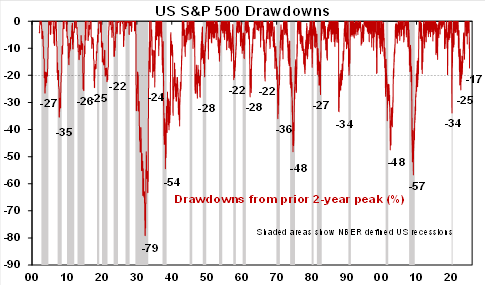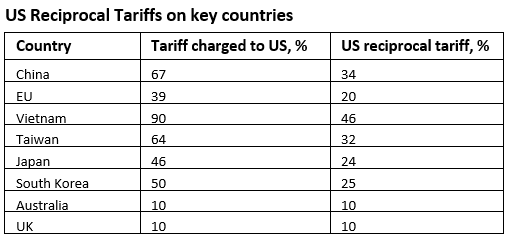The Trump Dump in shares – what does it mean for Australia and investors?
- Share markets have fallen further on US President Trump’s worse than expected tariff policies.
- Further weakness is likely but at some point, Trump is likely to pivot towards focusing more on his market-friendly policies and the Fed will step in with lower interest rates.
- For Australia, it means softer growth & more RBA rate cuts.
- This will weigh on short-term super fund returns but follows two years of very strong returns. The key for most investors is to stick to a long-term strategy.
The slump in share markets accelerated in the last week as Trump’s so called “Liberation Day” tariffs (more like Retro Day I reckon) were worse than expected, with China's retaliation adding to fears of a full-blown global trade war, all of which added to fears of a recession. From their February record highs US shares are down 17%, global shares are down 16% and the Australian shares are down 15%. Bonds and gold have rallied on safe haven demand and the $A and Bitcoin are down. As most of us have at least some of our wealth in shares via our superannuation such falls can be depressing, but seen in the context of share market history which often sees periodic sharp falls they are nothing new. So far, while the fall in US shares has been rapid (the 4th fastest two day fall since WWII), the total drop is mild when compared to the last 120 years.

Trump’s tariff hit
After two years of strong gains share markets started the year overvalued with above average price to earnings multiples and US shares offering no risk premium over bonds (as measured by the gap between the forward earnings yield and 10-year bond yields). Australian shares were not much better. This left shares vulnerable to bad news. The trigger for the slump though has been the Trump Administration’s often contradictory policy announcements around tariffs, public sector cutbacks and relations with allies, with tariffs going into hyperdrive last week. Trump announced so-called “reciprocal tariffs” supposed to offset trade barriers imposed by other countries. One would have hoped this would have reflected some attempt to quantify such unfair barriers but instead they were just based on the trade deficit the US has with each country divided by its imports from that country (see the second column in the next table) which was then halved because Trump is such a nice guy! (see third column). And because this doesn’t work for many like Australia & the UK, where the US has a trade surplus, it was set at a minimum 10% for such countries.

This - along with tariffs already imposed on China (add 20% to the 34% in the table above) along with 25% tariffs on Canada and Mexico and on steel, aluminium and cars - was far worse than expected and takes the average US tariff on imports to around 24%, well above levels seen in the 1930s. And Trump is threatening more tariffs on pharmaceuticals and copper. This is worse than levels Trump campaigned on – so maybe he should now be taken seriously and literally!
Putting aside issues like why the penguins on Heard and McDonald Islands were included, the reciprocal tariff formula is totally irrational. Even if a country has an overall trade balance it will have a deficit with some countries and a surplus with others reflecting comparative advantage in making things, and it makes no allowance for America’s chronic excessive national spending relative to its income as the key driver of its trade deficit. And that’s not the rest of the world “ripping it off”! This illogical starting point supposedly reflecting non-tariff barriers like biosecurity rules and value added taxes along with the 10% minimum will make it harder for other countries to negotiate down. It invites retaliation which we have already seen with China imposing a 34% tariff on US imports with a high risk other countries will follow and then the US counter retaliating.

Correction, grizzly bear or gummy bear?
Historically, the main driver of whether we see a correction (a fall of say 5% to 15%) or even a mild bear market with say a 20% or so decline that turns around relatively quickly like we saw in 2015-2016 in Australia – which may be called a “gummy bear market” – as opposed to a major “grizzly” bear market (like that in the mid-1970s or the global financial crisis when shares fell by around 55%) is whether we see a US recession. The first chart in this note & the next chart show that deep bear markets in US and Australian shares tend to be associated with a US recession.

Unfortunately, the risk of a US recession has gone up
The risk of a US recession was already rising with US households having run down their pandemic savings buffers and thanks to a further blow from the latest tariffs – which amount to a roughly $US600bn or 2% of GDP tax hike which is the biggest tax hike since 1968 - to confidence and supply chain disruptions is probably 45%. A rough estimate is that the hit to US growth will be 1%, with a similar amount added to inflation. Global growth could be pushed towards 2% (from 3% currently) depending on how significant retaliation is and how countries like China respond with policy stimulus. The US will be harder hit with threats to nearly all of its trade, whereas other countries only see their trade with the US tariffed.
Australia to see slower growth, but more RBA rate cuts
For Australia, the 10% US tariff on our exports is bad news for industries affected and there is likely more to come for pharmaceuticals (worth $2bn a year). However, only 5% of Australian exports go to the US worth about 0.9% of GDP and much of this will still continue albeit they are now more expensive in the US. So, all up the direct hit to GDP growth is probably only 0.1-0.2%. However, the bigger threat comes from the hit to global growth from Trump’s trade war, particularly in China and Asia, which will likely result in less demand for our exports posing a threat to the expected pick up in Australian economic growth. If we refrain from retaliatory tariffs on US imports (as appears likely), Trump's tariffs are more likely to hinder growth than boost inflation, supporting further RBA rate cuts. We had been forecasting 3 more 0.25% rate cuts (in August, November and February) but the Trump tariff shock means this could now be 4 or 5. While the $A has fallen to a five-year low around $US0.60, it fell 39% in the GFC and 19% in the pandemic and yet the RBA still cut rates then because the threat to growth swamped any threat of higher inflation and the same will likely apply in response to Trump’s tariff shock.
Shares likely have more downside
After big falls shares are now very oversold technically and so may see another short-term bounce. But while share valuations have improved they are still not cheap and given the now even bigger threat to growth flowing from Trump’s latest round of tariffs it looks like they will have a further leg down. This next leg could be driven by weaker hard data (like jobs and GDP). Our assessment has been that global and Australian shares will have a 15% plus correction measured from this year’s high. US shares have now had a 17% fall and Australian shares 15%, but more weakness looks likely taking shares into a bear market, ie, down 20% or more.

But what will stop shares falling?
A 10% fall in US shares was not enough to put pressure on Trump and so far Trump and his key advisers don’t seem too concerned e.g. Treasury Secretary Bessent not seeing the tariffs causing a recession. But several things will help the market eventually bottom and turn around:
First the ongoing plunge at some point - particularly as it goes beyond a 20% fall with headlines screaming “bear market” - will start to pressure Trump resulting in some moderation in the tariffs and refocus on the market positive aspects of his agenda, like tax cuts and de-regulation. In this regard the pressures on Trump are growing with four Republican Senators voting with Democrats to reject tariffs on Canada, Europe moving to purchase its own rather than US weapons, Musk looking like he is on the way out & there are signs of negotiation with Vietnam.
Second, shares are becoming cheaper with falling PEs and falling bond yields, gradually restoring value.
And the Fed at some point is likely to start easing again as fears about weaker growth will start to dominate tariff related inflation worries. The US money market is now allowing for more than four rate cuts this year.
But, we are not likely at a durable bottom just yet and so shares are likely to see more downside in the short term before more positive forces around Trump’s tax cuts & more Fed rate cuts get the upper hand
Key things for investors to bear in mind
Sharp share market falls are stressful for investors as no one likes to see their investments fall in value. And try as one may, it’s never easy to accurately predict economies and shares. So, at times like these it’s important to focus on basic investment principles. In particular, these things are worth keeping in mind (see here for more details):
- Share market pullbacks are healthy and normal - their volatility is the price we pay for the higher returns they provide over the long term.
- It’s very hard to time market moves so the key is to stick to an appropriate long-term investment strategy.
- Selling shares after a fall locks in a loss.
- Share pullbacks provide opportunities for investors to buy them more cheaply.
- Shares invariably bottom with maximum bearishness.
- Australian shares still offer an attractive income (or cash) flow relative to bank deposits.
- To avoid getting thrown off a long-term strategy, it’s best to turn down the noise around all the negative news flow
4 topics

